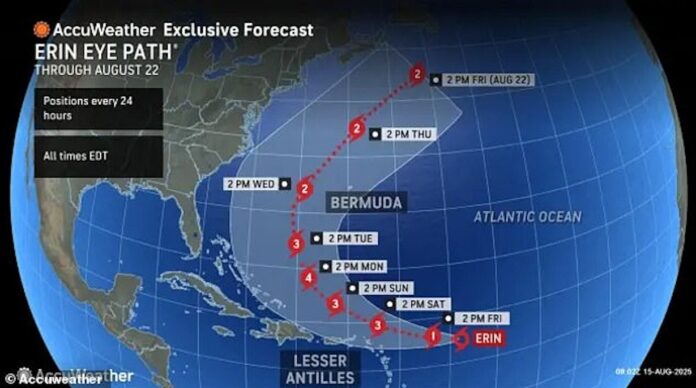- Hurricane Erin rapidly intensified, reaching Category 4 strength, threatening Bermuda and potentially the U.S. East Coast.
- Spaghetti models show most paths veering away from the U.S., but some scenarios could bring severe impacts to the Carolinas and Virginia.
- Residents face dangerous surf, coastal flooding, and strong winds, with the storm expected to affect New England by next week.
Hurricane Erin has rapidly intensified, setting off alarm bells along the U.S. East Coast. Early Friday reports confirmed sustained winds at 75 mph, officially elevating Erin to hurricane status. Meteorologists warn that the storm could strengthen further, potentially reaching a Category 4 intensity by Monday, with winds surpassing 130 mph as it nears Bermuda.
The storm’s journey began near the Cabo Verde Islands, where it already caused flash floods and tragically claimed lives in West Africa. Now, it looms over the Caribbean, threatening heavy rainfall, flooding, and dangerous seas. Tropical storm watches have been issued for islands including Anguilla, Barbuda, and St. Martin. Puerto Rico and the Virgin Islands are preparing for as much as six inches of rain, raising concerns about landslides and coastal flooding.
For residents in these regions, the news brings both urgency and anxiety. “We’re already sandbagging and moving boats to higher ground,” said a resident of St. Martin. “It’s stressful, but we hope everyone heeds the warnings.” The human cost in West Africa serves as a grim reminder that hurricanes don’t just disrupt lives—they take them.
The East Coast Watches Closely as Erin Approaches
Although current forecasts suggest Erin will veer north before hitting the mainland, unpredictability keeps people on edge. Weather models, sometimes called spaghetti models for the way they twist and overlap, largely agree on a northward path. Yet a few projections hint at a possible drift toward the Carolinas or even Virginia.
Alex DaSilva, lead hurricane expert at AccuWeather, cautioned that “the longer Erin travels west before turning north, the greater the chance of the storm impacting the East Coast.” His warning underlines the fine line between a storm brushing past offshore and a direct hit that could wreak havoc.
Even if Erin stays at sea, its effects are already surfacing along the coast. North Carolina’s Outer Banks are facing waves up to 12 feet, creating dangerous conditions for swimmers and surfers. Meanwhile, Long Island and Cape Cod are bracing for rough surf, high tides, and potential flooding. Coastal residents are monitoring the situation closely, balancing preparation with a sense of helplessness against nature’s power.
A Reminder of an Active Hurricane Season
NOAA had predicted an above-average hurricane season for 2025, with up to 19 named storms expected. Erin’s rapid growth highlights just how severe this season could become. The Atlantic hurricane season runs from June 1 to November 30, with the peak months yet to come, and Erin may be only the beginning of a busy and destructive period.
For many along the East Coast, the forecast fuels a mixture of vigilance and anxiety. Residents are stocking up on supplies, securing homes, and tracking every update from local authorities. Social media has become a flurry of advice, warnings, and firsthand accounts from people preparing for the storm. From sandbagging to last-minute evacuations, communities are rallying, showing resilience while confronting the uncertainty.
The Human Side: Fear and Preparedness
Public reaction has ranged from anxious preparation to cautious optimism. Many families have begun emergency drills, reviewed evacuation routes, and shared survival tips with neighbors. In some communities, volunteers are filling sandbags and reinforcing homes against the rising tide.
Yet, there’s also tension in the air. Social media posts reveal growing concern over storm surge and property damage. Some residents express frustration with the unpredictability of forecasts, unsure whether they should evacuate or stay put. “We can’t live in fear every storm, but we also can’t ignore it,” said a mother in Virginia. “It’s nerve-wracking, but we hope we’re making the right decisions.”
Officials emphasize that preparation is key. Coastal authorities are reminding residents to follow evacuation orders without delay and to avoid underestimating the storm’s potential impact. While many hope Erin will stay offshore, the storm’s erratic behavior keeps people on high alert.
Forecasts and What to Expect Next
As Erin continues its journey across the Atlantic, meteorologists will be monitoring its path closely. Although the majority of current models suggest a northward turn away from the U.S. coastline, small shifts in the storm’s trajectory could drastically alter its effect.
For now, residents from the Carolinas to New England are encouraged to stay informed and remain ready for anything. With hurricane season approaching its peak, Erin may be only the first of several storms testing coastal communities’ readiness and resilience. Emergency planners warn that even minor adjustments in the storm’s route could have major consequences, underscoring the unpredictable nature of hurricanes.
Communities are preparing for all possibilities. Officials continue to issue advisories, coordinate sandbag distribution, and alert emergency services. Meanwhile, families are gathering supplies, moving vehicles to safer locations, and ensuring loved ones are accounted for. The tension between hope and anxiety is palpable, reflecting the delicate balance communities must maintain in the face of nature’s fury.




